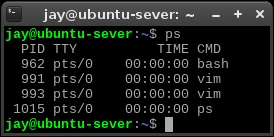While managing
our server, we'll need to understand what processes are running and how to manage these processes. Later in this chapter, we'll work through starting, stopping, and monitoring processes. But before we get to those concepts, we first need to be able to determine what is actually running on our server. The ps command allows us to do this.
When executed by itself, the ps command will show a list of processes running by the user that called the command.

The output of the ps command, when run as a normal user and with no options
In the example screenshot I provided, you can see that when I ran the ps command as my own user with no options, it showed me a list of processes that I am running as myself. In this case, I have a couple of vim sessions open, and in the last line, we also see ps itself, which is also included in the output.
On the left side of the output, you'll see a number for each of the running processes. This is known as...



